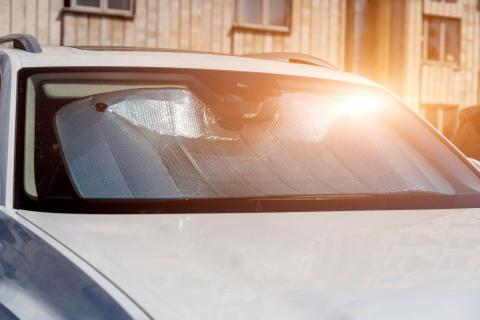How to protect your car from sun damage

In the 1997 movie Breakdown, the protagonist's car breaks down due to the extreme heat on a desert highway near Arizona, leading to an unexpected detour. It’s no wonder the story takes place in the Southwest, a region where heat and dry weather affect many, including those wondering how to prevent sun damage to their car.
As many drivers know, the relentless sun, triple-digit temperatures, and extreme heat can put a real strain on their cars. Agencia de Seguros de Accesso, LLC (A Abana Insurance) understands the concerns drivers in this region have.
The desert sun and dry climate can cause more than cosmetic damage to your vehicle. Mechanical failures also occur without proper prevention. Let’s take a look at the different ways sun damage affects cars and how to prevent them.
Ways the sun and high temperatures can damage cars
After 40 minutes of exposure on an 80-degree day, the inside of a car can get as hot as 118 degrees, according to the CDC. Considering temperatures in cities like Phoenix continue to rise over the years, reaching triple digits, the sun and heat can cause damage such as:
1. Shorter car battery life
Exposure to high temperatures can cause damage to car batteries. If the fluid evaporates, the battery can break down faster. Internal corrosion and casing swelling can also be triggered by heat, shortening your battery life.
2. Cosmetic damage
Many drivers notice their vehicle’s paint begins to fade or crack under long sun exposure. This is due to the sun’s UV rays breaking down the outer paint layer. Additionally, leaving your vehicle exposed to harsh temperatures can cause the plastic and vinyl inside to fade or warp and the seats to crack.
3. Tire damage
Arizona drivers experience a lot more tire blowouts during the summer months, according to experts. High temperatures cause air to expand, leading to a higher risk of tire blowouts. Additionally, high heat and hot asphalt can cause rubber to degrade faster.
4. Worn-down radiator and cooling system
During high temperatures, coolant breaks down more quickly. The radiator, which dissipates heat from the coolant by releasing this heat into the air, can begin to rust or wear down under extreme conditions. In turn, this can lead to a damaged engine.
5. Overstrained AC system
Your car’s AC system will be working extra hard during the summer months. Overstrain can cause leaks, increase system pressure, and damage the compressor, the heart of your car’s AC system.
How Arizona drivers protect their cars from sun damage
Despite the dangers of sun damage and high heat, preventative measures can help you keep your car in good shape. So, what are some strategies drivers take to prevent vehicle sun damage?
1. They park in the shade
Shade can significantly reduce temperatures, even during high summer. Parking under the shade of a building or roof, or even paying for a shaded spot, can prevent paint and interior vehicle damage.
If you park under a tree’s shade, check if sap may drip or fruits and branches may fall. Such debris can react under the sunlight and exacerbate any exterior damage.
Additionally, some drivers opt for a weather-protection cover, which can be an affordable option in case covered parking is not available.
2. They use UV protection
Some experts suggest waxing your car once per season or every few months. Wax can provide a layer of protection against the sun’s UV rays.
Although Arizona tinting laws vary depending on the size of your vehicle, front-side windows are generally required to allow more than 33% of light in. For windshields, drivers can generally add non-reflective tint above the manufacturer’s AS-1 line. This line, marked by a manufacturer, usually lies five to six inches from the top of the windshield.
Washing your vehicle regularly will also prevent dust and debris from accumulating. This debris can react with the sun’s UV rays and speed up fading.
3. They stay on top of car maintenance
To keep their car in good shape, drivers often check their vehicle fluids, such as coolant, transmission and brake fluids, and oil. They test the battery, radiator, AC system, and check for signs of damage.
Additionally, regularly checking their tire pressure and looking for wear and tear helps them avoid a blown tire. The Arizona Department of Transportation recommends using a tire pressure gauge to check for pressure when tires are cold, at least three hours after driving.
Consulting a professional mechanic for regular checkups and car maintenance helps spot potential issues and prevent accidents or getting stuck somewhere on the road.
4. They prepare for long road trips or summer driving
Before a long summer drive, cautious drivers check their fluids, motor oil, engine, and tires. They often top off their coolant since it prevents overheating.
Prepared drivers also test their batteries. Older batteries (three to five years old) are more likely to die. They’ll promptly notice any dashboard warning lights and attend to them, or take their vehicle to their local dealer or mechanic.
Additionally, bringing an emergency kit with jumper cables, flashlights, water, basic tools, and flares or traffic cones can help in the case of a failed engine or battery.
Before going on a long trip, many drivers will check that their car insurance policy is up to date. They’ll also note any important contact numbers so they know who to call in case of an emergency.
When to talk to your insurance agent
It’s important to consider maintaining your car regularly so you don’t have to deal with sun damage, as most insurance companies won’t cover gradual deterioration caused by the sun. Comprehensive coverage may cover the costs of damages caused by extreme weather events, however. For instance, if an extreme heat incident caused a wild or electrical fire which damaged your vehicle, comprehensive insurance may help cover the costs of repairs.
Other Arizona extreme weather events that may be covered by comprehensive coverage include:
- Flash floods
- Tornadoes
- Dust storms
Comprehensive coverage may also help cover the costs of damages caused by:
- Falling objects
- Theft or vandalism
- Animals damaging your car
However, many policies exclude normal aging and routine wear, so speaking with an agent can help you understand what your policy will cover.
At A Abana, our agents are ready to answer your insurance-related questions. Call 214-764-8868, visit one of our stores, or get a free auto insurance quote online.
Disclaimer:
This material is for general informational purposes only. Products, services, and discounts referenced herein are not available in all states or in all companies. All statements are subject to the terms, exclusions, and conditions of the applicable policy. In all instances, current policy contract language prevails. Coverage is subject to individual policyholders meeting the insurer's underwriting qualifications and state availability. Other terms, conditions, and exclusions may apply.






